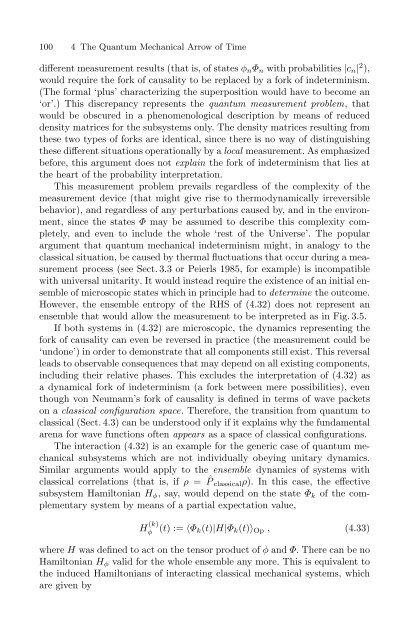The Physical Basis of The Direction of Time (The Frontiers ...
The Physical Basis of The Direction of Time (The Frontiers ...
The Physical Basis of The Direction of Time (The Frontiers ...
Create successful ePaper yourself
Turn your PDF publications into a flip-book with our unique Google optimized e-Paper software.
100 4 <strong>The</strong> Quantum Mechanical Arrow <strong>of</strong> <strong>Time</strong><br />
different measurement results (that is, <strong>of</strong> states φ n Φ n with probabilities |c n | 2 ),<br />
would require the fork <strong>of</strong> causality to be replaced by a fork <strong>of</strong> indeterminism.<br />
(<strong>The</strong> formal ‘plus’ characterizing the superposition would have to become an<br />
‘or’.) This discrepancy represents the quantum measurement problem, that<br />
would be obscured in a phenomenological description by means <strong>of</strong> reduced<br />
density matrices for the subsystems only. <strong>The</strong> density matrices resulting from<br />
these two types <strong>of</strong> forks are identical, since there is no way <strong>of</strong> distinguishing<br />
these different situations operationally by a local measurement. As emphasized<br />
before, this argument does not explain the fork <strong>of</strong> indeterminism that lies at<br />
the heart <strong>of</strong> the probability interpretation.<br />
This measurement problem prevails regardless <strong>of</strong> the complexity <strong>of</strong> the<br />
measurement device (that might give rise to thermodynamically irreversible<br />
behavior), and regardless <strong>of</strong> any perturbations caused by, and in the environment,<br />
since the states Φ may be assumed to describe this complexity completely,<br />
and even to include the whole ‘rest <strong>of</strong> the Universe’. <strong>The</strong> popular<br />
argument that quantum mechanical indeterminism might, in analogy to the<br />
classical situation, be caused by thermal fluctuations that occur during a measurement<br />
process (see Sect. 3.3 or Peierls 1985, for example) is incompatible<br />
with universal unitarity. It would instead require the existence <strong>of</strong> an initial ensemble<br />
<strong>of</strong> microscopic states which in principle had to determine the outcome.<br />
However, the ensemble entropy <strong>of</strong> the RHS <strong>of</strong> (4.32) does not represent an<br />
ensemble that would allow the measurement to be interpreted as in Fig. 3.5.<br />
If both systems in (4.32) are microscopic, the dynamics representing the<br />
fork <strong>of</strong> causality can even be reversed in practice (the measurement could be<br />
‘undone’) in order to demonstrate that all components still exist. This reversal<br />
leads to observable consequences that may depend on all existing components,<br />
including their relative phases. This excludes the interpretation <strong>of</strong> (4.32) as<br />
a dynamical fork <strong>of</strong> indeterminism (a fork between mere possibilities), even<br />
though von Neumann’s fork <strong>of</strong> causality is defined in terms <strong>of</strong> wave packets<br />
on a classical configuration space. <strong>The</strong>refore, the transition from quantum to<br />
classical (Sect. 4.3) can be understood only if it explains why the fundamental<br />
arena for wave functions <strong>of</strong>ten appears as a space <strong>of</strong> classical configurations.<br />
<strong>The</strong> interaction (4.32) is an example for the generic case <strong>of</strong> quantum mechanical<br />
subsystems which are not individually obeying unitary dynamics.<br />
Similar arguments would apply to the ensemble dynamics <strong>of</strong> systems with<br />
classical correlations (that is, if ρ = ˆP classical ρ). In this case, the effective<br />
subsystem Hamiltonian H φ , say, would depend on the state Φ k <strong>of</strong> the complementary<br />
system by means <strong>of</strong> a partial expectation value,<br />
H (k)<br />
φ (t) :=〈Φ k(t)|H|Φ k (t)〉 Op , (4.33)<br />
where H was defined to act on the tensor product <strong>of</strong> φ and Φ. <strong>The</strong>recanbeno<br />
Hamiltonian H φ valid for the whole ensemble any more. This is equivalent to<br />
the induced Hamiltonians <strong>of</strong> interacting classical mechanical systems, which<br />
are given by



![arXiv:1001.0993v1 [hep-ph] 6 Jan 2010](https://img.yumpu.com/51282177/1/190x245/arxiv10010993v1-hep-ph-6-jan-2010.jpg?quality=85)


![arXiv:1008.3907v2 [astro-ph.CO] 1 Nov 2011](https://img.yumpu.com/48909562/1/190x245/arxiv10083907v2-astro-phco-1-nov-2011.jpg?quality=85)








![arXiv:1002.4928v1 [gr-qc] 26 Feb 2010](https://img.yumpu.com/41209516/1/190x245/arxiv10024928v1-gr-qc-26-feb-2010.jpg?quality=85)
![arXiv:1206.2653v1 [astro-ph.CO] 12 Jun 2012](https://img.yumpu.com/39510078/1/190x245/arxiv12062653v1-astro-phco-12-jun-2012.jpg?quality=85)
